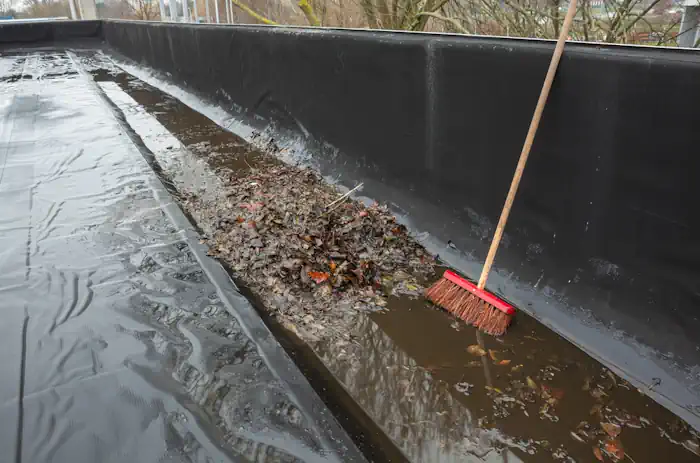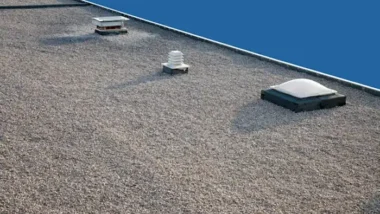So, you’re considering a flat roof for your building. You’ve heard the rumors, the skepticism, the horror stories. ‘Flat roofs always leak!’ ‘They’re a maintenance nightmare!’ ‘You’ll be replacing it every five years!’

But is any of this actually true? How long does a flat roof typically last?
Well, let’s start with the obvious: a flat roof is flat. Unlike a sloped roof, there’s nowhere for water to run off, which can lead to pooling and potential leaks. But don’t let this discourage you! Flat roofs can be just as durable and long-lasting as sloped roofs, if you choose the right materials and the proper drainage, maintain them properly, and take climate factors into consideration.
In general, flat roofs can last between 10 to 30 years, depending on various factors such as the type of roofing material used, installation quality, climate conditions, maintenance, and regular inspections. It’s important to note that different roofing materials have different lifespans, and proper maintenance can significantly extend the longevity of a flat roof.
In this article, we’ll delve into these various factors that can influence the lifespan of a flat roof, as well as examine the different materials available and the maintenance required to keep your flat roof in top shape.
So, let’s get started and put those flat roof myths to rest once and for all.
Key Takeaways
- Proper maintenance and materials can make flat roofs durable
- Lifespan is affected by construction quality, usage patterns, installation errors, and weather conditions
- Five common options for flat roofing: built-up roofing, modified bitumen, EPDM, PVC, TPO
- Regular inspections, cleaning, and professional repair services are important for maintenance and extending lifespan
Factors Influencing Longevity: Understanding the Lifespan of Flat Roofs
If you want to avoid the headache and expense of frequent repairs, it’s crucial to understand the factors that influence the lifespan of flat roofs.
One of the most important factors is construction quality. The way a flat roof is built can have a big impact on how long it lasts. For example, if a roof is built with cheap materials or shoddy workmanship, it will likely deteriorate much faster than a roof that was built with high-quality materials and expert craftsmanship.
Another factor that can influence the lifespan of a flat roof is usage patterns. The more people who occupy a building with a flat roof, and walk on that flat roof, the more wear and tear it will experience. This can lead to faster deterioration and a shorter lifespan.
Finally, installation errors can also play a role in how long a flat roof lasts. Even minor mistakes during installation can lead to significant problems down the road, so it’s important to work with a reputable contractor who has experience installing flat roofs.
Material Matters: Examining Durability and Longevity of Flat Roofing Options
When it comes to roofing materials, some hold up better over time than others. Flat roofs are no exception, and the type of material used can greatly impact the longevity of the roof. Here are five common flat roofing options and some factors to consider when it comes to durability and longevity:
- Built-Up Roofing (BUR): A traditional option that involves multiple layers of felt and asphalt. BUR is known for its durability, but can be costly and time-consuming to install.
- Modified Bitumen: A more modern version of BUR that is easier to install and provides better protection against weathering. However, it may not last as long as BUR.
- EPDM: A synthetic rubber material that is highly durable and resistant to weathering. It is also cost-effective, but may not be the best option for environmentally conscious homeowners.
- PVC: A highly reflective and energy-efficient option that is resistant to weathering and can last up to 30 years. However, it can be more expensive than other options.
- TPO: A newer option that is similar to PVC, but typically more cost-effective. It is also highly reflective and energy-efficient, but may not be as durable as other options.
When choosing a flat roofing material, it’s important to weigh the cost effectiveness, installation process, and environmental impact. Consider your budget, the climate in your area, and your personal values to determine the best option for your home.
Maintenance Matters: The Role of Proper Care in Extending Flat Roof Lifespan
To keep your flat roofing material in top condition and avoid costly repairs, you must regularly maintain and inspect it. Regular inspections help to identify potential issues before they become major problems. It’s important to create a cleaning schedule to keep debris from gathering on the roof and causing damage. A clean roof also allows for proper drainage and prevents water from pooling, which can lead to leaks and other issues.

In addition to regular inspections and cleaning, it’s important to hire professional repair services when needed. Trying to fix issues on your own can often lead to further damage and more costly repairs down the line. A professional roofing company can identify any issues and provide the necessary repairs to extend the lifespan of your flat roof. By staying on top of maintenance and repair needs, you can ensure that your flat roof lasts for many years to come.
| Regular Inspections | Cleaning Schedule | Repair Services |
|---|---|---|
| Inspect for damage or wear | Clear debris from roof | Hire professional repair services |
| Look for signs of leaks | Keep gutters and drains clear | Address issues promptly |
| Check for proper drainage | Remove snow and ice buildup | Use quality materials for repairs |
| Identify potential issues early | Address any problems promptly to prevent further damage. | Ensure repairs are done correctly |
| Maintain overall roof health | Schedule regular maintenance | Follow manufacturer recommendations |
Climate Considerations: How Weather Conditions Impact Flat Roof Longevity
Weather conditions greatly affect the lifespan of flat roofs. Extreme temperatures and harsh weather patterns can cause significant damage over time. Here are some factors to consider when it comes to climate and flat roof longevity:
- Both hot and cold weather can be detrimental to flat roofs. In hot climates, the sun’s UV rays can break down the materials of the roof, causing cracks and leaks. In cold climates, the expansion and contraction of the roof due to temperature changes can also lead to damage over time.
- Rain, snow, and ice can all take a toll on a flat roof. If water is not properly drained from the roof, it can seep into cracks and cause damage to the structure underneath. Additionally, if snow and ice are not cleared from the roof, the weight can put stress on the roof and cause it to collapse.
It’s important to take these climate considerations into account when determining the lifespan of a flat roof. Proper maintenance, such as regular inspections and repairs, can help to mitigate the effects of extreme temperatures and precipitation.
Signs of Aging: Recognizing Common Indicators of a Flat Roof’s Deterioration
You can easily identify signs of your flat roof’s aging by looking for common indicators such as cracks, leaks, and sagging in the roof structure. It’s important to inspect your flat roof regularly to catch any signs of deterioration early on.
Inspection frequency will depend on several factors, such as the age of the roof, the climate in your area, and the type of roofing material used. If you notice any signs of aging on your flat roof, it’s important to address them as soon as possible.
Repair options may include patching up leaks, reinforcing weakened areas, and replacing damaged sections of the roof. The cost of repairs will depend on the extent of the damage and the materials and labor required. However, if the roof is severely damaged or has reached the end of its lifespan, replacement may be necessary.

Replacement costs will depend on several factors, such as the size of the roof, the type of roofing material, and the complexity of the installation process. It’s important to consult with a roofing professional to determine the best course of action for your flat roof.
Frequently Asked Questions
Is it possible to extend the lifespan of a flat roof beyond its typical lifespan?
To extend the lifespan of your flat roof beyond the typical period, prioritize roof maintenance, including regular cleaning and repair of any damages. Additionally, have a professional inspection done regularly and ensure proper weather protection measures are in place.
What are some common mistakes that can shorten the lifespan of a flat roof?
To avoid shortening the lifespan of your flat roof, be mindful of common mistakes such as neglecting regular maintenance, failing to address leaks promptly, and choosing subpar repair options. Follow proper maintenance tips and seek professional assistance when needed.
Can flat roof materials be recycled or repurposed after they reach the end of their lifespan?
Did you know that flat roof materials can be recycled or repurposed after they reach the end of their lifespan? Recycling options vary based on the type of material and market demand, but it’s a great way to minimize environmental impact.
How does the slope of a flat roof affect its longevity?
The slope of a flat roof can significantly impact its longevity. Proper drainage design and waterproofing options are crucial to prevent water buildup and damage. Consider hiring a professional to ensure your flat roof lasts for years to come.
Are there any alternative materials or construction methods for flat roofs that offer longer lifespans?
If you’re looking for sustainable options, consider using green roofs or solar panels. Cost comparison and durability factors should also be considered. However, traditional flat roofs with proper maintenance can last up to 25 years.
Finally…
You now have a better understanding of the factors that impact the longevity of flat roofs. By examining the materials used, the level of maintenance provided, and the climate conditions, you can be sure that your flat roof lasts as long as possible.
Remember, taking care of your roof can save you money in the long run and prevent costly repairs. As the saying goes, “an ounce of prevention is worth a pound of cure.” Regular inspections, prompt repairs, and proper maintenance can help you avoid the headache of a deteriorating flat roof.
Don’t wait until it’s too late – take the necessary steps to extend the lifespan of your flat roof today. By doing so, you’ll be able to enjoy the peace of mind that comes with knowing your roof is in good hands for years to come.

